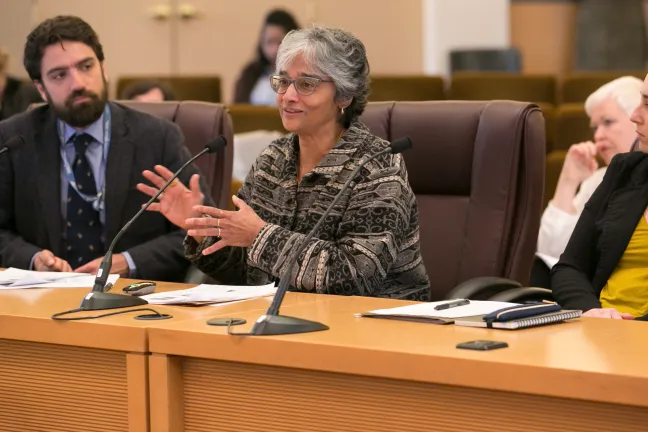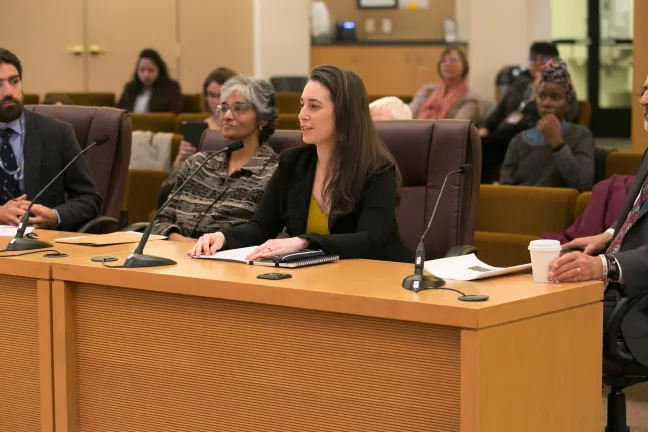Pollution continues to threaten public health in Multnomah County despite state and regional commitments to curb greenhouse gas emissions, experts said Tuesday during a briefing on air quality policy and emission research.
Multnomah County has cut emissions from its fleet and buildings by more than half in the last year. It also established rules to reduce diesel pollution on publicly funded construction projects and has partnered with regional governments to establish a regional Clean Air Construction Collaborative.
The County works with Washington County to curtail wood smoke. And its Office of Sustainability helps connect local researchers and environmental organizations through the Advisory Committee for Sustainability and Innovation.
Yet Multnomah County residents still breathe the dirtiest air in the state and face the highest risk of pollution-related cancer. Rising ozone levels in Multnomah County have jeopardized the state’s compliance with the federal Clean Air Act. And deadly diesel emissions continue unabated as old, dirty motors land in Oregon — driven here from neighboring states with tighter environmental regulations.
State lawmakers vowed in 2007 to dramatically reduce emissions, but pollution remains on the rise. New findings from a study commissioned by Multnomah County and the County of Portland find some residents breath in up to 25 times the state’s already lenient limits of diesel.
“It’s important to highlight that, despite our green reputation, our air quality is poor and we can do something about it,” Chair Deborah Kafoury said Tuesday. “I appreciate you talking about some ways we’re working to bring down the levels. We know we have so much work to do.”
The Risk
Air pollution increases a person’s risk of developing lung cancer, asthma, and cardiovascular disease. It can cause babies to be born too soon and too small. It can promote diabetes and neurological disorders in children. Globally, pollution is estimated to be responsible for a quarter of all deaths from lung cancer, stroke, and heart disease.
In the United States, the vast majority of pollution is generated by white residents, but inhaled by people of color, a new study shows. Most Oregonians face an increased risk of cancer because of air pollution, but residents in Multnomah County — and people of color specifically — face a risk higher than in any other place in the state, and at a rate well above the national average.
Individuals have some power to shape their health. Plant-based diets, avoiding tobacco, and regular exercise play a bigger role in a person’s health than genetics. But people often can’t choose how closely they live to pollution sources, especially in a tight housing market.
“Unlike other behaviors, like choosing not to consume unhealthy food, we can’t choose not to breathe,” said Jae Douglas, Ph.D., Multnomah County Environmental Health Services director. “It’s virtually impossible to have a healthy community and unhealthy air.”
Mobile sources including trucks, cars, trains, and construction equipment are most likely to spew dangerous emissions. Those sources are the main driver of air pollution in the Portland metro region. But emissions from other sources are a strong contender, generated by daily activities such as burning wood, using solvents and raising livestock.
And while regional air quality from these sources might remain below a level that could trigger consequences from the U.S. Environmental Protection Agency, people in certain neighborhoods and schools breath toxic air.
What’s in the Air
Federal regulators enforce maximum emission levels of six common air pollutants, including Particulate Matter 2.5, the tiny toxic particles found in car exhaust and wood smoke.
Short-term exposure to particulate matter in wood smoke can aggravate asthma, bronchitis and lung disease. Long-term exposure has been linked to cancer and higher rates of infant mortality. It also contributes a surprising 11 percent of the County’s increased cancer risk from air pollution.
“A growing body of scientific literature suggests wood smoke can be harmful to health even when we can’t see it or smell it,” said Nadège Dubuisson, who coordinates air quality work for the Multnomah County Environmental Health Division.
The health effects of wood smoke are worse when the air is stagnant and cool, so Multnomah County passed an ordinance in 2018 to protect people on the worst air quality days of winter. During the first full season, which ran from Oct. 1, 2018, through March 1 of this year, the County called two “red” no-burn days and 21 “yellow” voluntary no-burn days, Dubuisson said Tuesday.
Complaints came in about seven households during no-burn days, prompting Dubuisson to share information with those families on clean burning and the health effects of wood smoke. The County issued no penalties.
“There was a big focus on education,” she said. “We’re not looking to fine people.”
A survey of people who signed up to receive burn notices shows the program is working, she said. Sixty-five percent of those who responded said they burned less wood as a result.
Multnomah County is also pushing state legislators to support Senate Bill 1031, which would support a Residential Solid Fuel Heating Air Quality Improvement Fund to help low-income households who rely on wood-fueled heat to upgrade to cleaner-burning stoves.
But Particulate Matter 2.5 — the fine inhalable particles in wood smoke that can cause health problems and are commonly called PM2.5 — comes from other common sources, too, including factories, cars and trucks. Mobile sources also are driving the County’s dangerous levels of pollutants such as Benzene, Acetaldehyde and ground-level ozone.
Ground-level ozone, which is regulated by the Environmental Protection Agency, comes from a chemical reaction between nitrogen oxide gases and volatile organic compounds, each released when fuel such as gasoline or natural gas ignites.
Oregon overall has remained below the legal cap for ozone emissions, but Multnomah County exceeded that limit for the past two years, Ali Mirzakhalili, air quality administrator for the Oregon Department of Environmental Quality, told Commissioners on Tuesday. Severe wildfire seasons likely contributed to the rise, he said, but that analysis is still incomplete.
“You improve air quality by reducing pollution, so you need to identify where pollution comes from,” he said, pointing to charts that showed the leading sources of nitrogen oxides and volatile organic compounds. “Here’s what’s contributing to our problem.”
Cars and trucks operating in Multnomah County are the leading source of each.
Dirty Diesel
One cancer-causing pollutant that federal regulators don’t control, and the state of Oregon doesn’t regulate, comes from the tailpipes of diesel-burning vehicles. The World Health Organization has long qualified diesel engine exhaust as a known carcinogen, even as the United States has stopped short. Diesel particulate matter — known as diesel PM 2.5 — is one of 188 air pollutants the federal government has recognized but doesn’t cap.
Although regulators never declared diesel a known carcinogen, California did, and established exposure limits of .003 micrograms per cubic meter. California passed laws to phase out older diesel engines by 2023. Oregon, meanwhile, established an exposure limit on diesel exhaust of .1 micrograms per cubic meter —30 times higher than California’s limit — but doesn’t enforce it.
And Oregon’s limit remains so far from current measures that the Portland region would have to reduce diesel emissions by 90 percent to reach even that benchmark. Oregon lawmakers this spring are considering a bill that would phase in emission standards for some diesel trucks.
Linda George, Ph. D., a researcher at Portland State University, has studied diesel particulate since 2006. But it wasn’t that undeniable health hazard that raised public alarm and prompted the state to act on air pollution.
“Let me take you back to 2016,” George said Tuesday. She summarized
The events led to the creation of Cleaner Air Oregon, a health-risk-based regulatory program that added requirements to the state’s industrial permitting and oversight functions.
“That raised awareness like nothing in my 30-year career,” George said.
Concerns about heavy metals in Portland’s air spurred Multnomah County and the City of Portland in 2016 to partner with George on a regional study to examine heavy metals captured by hand-held monitors positioned in neighborhoods most at risk.
George teamed up with students to launch the Neighborhood Air Quality Project. Over the following months, they gathered data on heavy metals from 500 monitors in four areas including the Cully neighborhood and in Southeast Portland near Precision Castparts.
Initially, “except for arsenic, we didn’t see any levels elevated above the Cleaner Air Oregon cancer action levels,” she said.
Arsenic is commonly found in the region’s soil and dust, and elevated rates were not surprising. But as the team pulled soot-covered filters from their monitors to study them, George had a thought.
“I was not satisfied getting nothing from all that work,” she told the Board.
So she bought an instrument to test levels of black carbon, a surrogate for diesel pollution. The levels in every neighborhood came back more than five times the state’s exposure limit — with some approaching 25 times.
“This gives us some pause,” she said Tuesday. “What real issues are in the Portland area?”
George suggests regulators look to the roads. Her office partnered with Portland Public Schools to evaluate the health risk to students at Harriet Tubman Middle School, located in Northeast Portland about 50 feet from Interstate 5.
“The freeway was obviously the source of pollution affecting the school,” George said. “The health impacts are significant. Every day I come across outcomes on health, diabetes, depression, ear infections.”
Those increased risks exist as much as 500 meters from any interstate highway. In Portland alone, she found, 149 other schools operate 500 meters or closer to a freeway, “with Tubman being the closest,” she said, noting a plan by the Oregon Department of Transportation to add lanes to Interstate 5 that would put the school “not 50 feet but 25 feet from that freeway.”
Portland Public Schools installed a $200,000 air filtration system at Tubman during recent renovations. Children playing outside during recess will still breathe in the particulate from passing cars. But once inside the building, they’ll breathe easy.
“The air inside is really kind of the cleanest air in the City of Portland,” she said. “If you want clean air, go to Harriet Tubman.”



